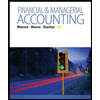
Concept explainers
Describe how total variable costs and unit variable costs behave with changes in the level of activity.
Describe the behavior of the total variable costs and unit variable costs with changes in the level of activity.
Explanation of Solution
Cost Behavior: It refers to the method in which a cost changes with respect to the changes in its related activities. This method helps the management in estimating costs for decision making and predict future profits.
Describe the behavior of the total variable costs and unit variable costs with changes in the level of activity as follows:
The total variable costs changes proportionately with respect to the changes in the level of activity. However, the unit variable costs remains constant irrespective to the changes in the level of activity.
Want to see more full solutions like this?
Chapter 6 Solutions
Managerial Accounting
- General accountingarrow_forwardCan you help me solve this general accounting question using the correct accounting procedures?arrow_forwardQuestion 5 of 11 Your answer is partially correct. 8.87/14 E ! Here are selected 2027 transactions of Riverbed Company. Jan. 1 June 30 Dec. 31 Retired a piece of machinery that was purchased on January 1, 2017. The machine cost $63,000 and had a useful life of 10 years with no salvage value. Sold a computer that was purchased on January 1, 2024. The computer cost $40,300 and had a useful life of 5 years with no salvage value. The computer was sold for $15,100 cash. Discarded a delivery truck that was purchased on January 1, 2023. The truck cost $33,780. It was depreciated based on a 6-year useful life with a $3,000 salvage value. Journalize all entries required on the above dates, including entries to update depreciation on assets disposed of where applicable. Riverbed Company uses straight-line depreciation. (Assume depreciation is up to date as of December 31, 2026.) (List all debit entries before credit entries. Credit account titles are automatically indented when amount is…arrow_forward
- I need help solving this general accounting question with the proper methodology.arrow_forwardCan you explain the correct methodology to solve this general accounting problem?arrow_forwardwork Question 6 of 11 Pronghorn Company, organized in 2025, has the following transactions related to intangible assets. 1/2/27 Purchased patent (8-year life) $592,000 4/1/27 *Goodwill (indefinite life) 375,000 7/1/27 Acquired 10-year franchise; expiration date 7/1/2037 520,000 9/1/27 Incurred research and development costs 178,000 4.74/14 E *The goodwill resulted from the purchase of a small company for cash in the amount of $750,000. At the time of acquisition, the fair value of the assets totaled $1,850,000, and the fair value of the liabilities totaled $1,475,000. (a1) Your answer is partially correct. Prepare the necessary entries to record these intangibles. All costs incurred were for cash. Make the adjusting entries as of December 31, 2027, recording any necessary amortization and reflecting all balances accurately as of that date. (List all debit entries before credit entries. Credit account titles are automatically indented when amount is entered. Do not indent manually.…arrow_forward
- Hii, Tutor Give answerarrow_forwardCH 20 Master Budgets Extra Credit 6 Required information Part 2 of 2 3.35 points Saved Problem 20-2A (Algo) Manufacturing: Cash budget and schedule of cash payments LO P2 [The following information applies to the questions displayed below.] Built-Tight is preparing its master budget. Budgeted sales and cash payments follow: Budgeted sales July $ 56,500 August $ 72,500 September $ 55,500 Budgeted cash payments for eBook Direct materials Direct labor Overhead 15,660 3,540 19,700 12,940 2,860 16,300 13,260 2,940 16,700 Ask Print References Mc Graw Hill Help Save & Exit Submit Sales to customers are 20% cash and 80% on credit. Sales in June were $54,000. All credit sales are collected in the month following the sale. The June 30 balance sheet includes balances of $45,000 in cash and $4,500 in loans payable. A minimum cash balance of $45,000 is required. Loans are obtained at the end of any month when the preliminary cash balance is below $45,000. Interest is 1% per month based on the…arrow_forwardDanbury Processing combines corn husks and methanol. After joint manufacturing costs of $4,200 have been incurred, the mixture separates into two products, cellulose fiber and methyl esters. At the split-off point, cellulose fiber can be sold for $8,300, and the methyl esters can be sold for $12,700. The cellulose fiber can be further processed at a cost of $9,100 to make biodegradable packaging, which could be sold for $21,500. The methyl esters can be further processed at a cost of $7,800 to make biodiesel, which could be sold for $18,900. What is the net increase (decrease) in operating income from biodegradable packaging?arrow_forward
- Which of the following is true about the statement of cash flows?a) It shows the profitability of the businessb) It shows how cash is generated and used in operating, investing, and financing activitiesc) It is prepared only at year-endd) It does not include cash transactions from financing activitiesneed help!arrow_forwardWhich of the following is true about the statement of cash flows?a) It shows the profitability of the businessb) It shows how cash is generated and used in operating, investing, and financing activitiesc) It is prepared only at year-endd) It does not include cash transactions from financing activitiesarrow_forwardCan you help me solve this financial accounting question using the correct financial procedures?arrow_forward
 Survey of Accounting (Accounting I)AccountingISBN:9781305961883Author:Carl WarrenPublisher:Cengage Learning
Survey of Accounting (Accounting I)AccountingISBN:9781305961883Author:Carl WarrenPublisher:Cengage Learning Managerial AccountingAccountingISBN:9781337912020Author:Carl Warren, Ph.d. Cma William B. TaylerPublisher:South-Western College Pub
Managerial AccountingAccountingISBN:9781337912020Author:Carl Warren, Ph.d. Cma William B. TaylerPublisher:South-Western College Pub Financial And Managerial AccountingAccountingISBN:9781337902663Author:WARREN, Carl S.Publisher:Cengage Learning,
Financial And Managerial AccountingAccountingISBN:9781337902663Author:WARREN, Carl S.Publisher:Cengage Learning, Financial & Managerial AccountingAccountingISBN:9781285866307Author:Carl Warren, James M. Reeve, Jonathan DuchacPublisher:Cengage Learning
Financial & Managerial AccountingAccountingISBN:9781285866307Author:Carl Warren, James M. Reeve, Jonathan DuchacPublisher:Cengage Learning AccountingAccountingISBN:9781337272094Author:WARREN, Carl S., Reeve, James M., Duchac, Jonathan E.Publisher:Cengage Learning,
AccountingAccountingISBN:9781337272094Author:WARREN, Carl S., Reeve, James M., Duchac, Jonathan E.Publisher:Cengage Learning, Accounting (Text Only)AccountingISBN:9781285743615Author:Carl Warren, James M. Reeve, Jonathan DuchacPublisher:Cengage Learning
Accounting (Text Only)AccountingISBN:9781285743615Author:Carl Warren, James M. Reeve, Jonathan DuchacPublisher:Cengage Learning





